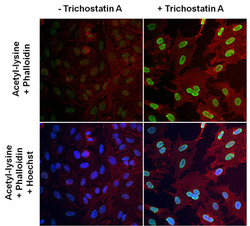Antibody data
- Antibody Data
- Antigen structure
- References [1]
- Comments [0]
- Validations
- Western blot [3]
- Immunocytochemistry [1]
- Immunoprecipitation [2]
- Other assay [1]
Submit
Validation data
Reference
Comment
Report error
- Product number
- GTX80693 - Provider product page

- Provider
- GeneTex
- Proper citation
- GeneTex Cat#GTX80693, RRID:AB_625365
- Product name
- Acetyl Lysine antibody [1C6]
- Antibody type
- Monoclonal
- Antigen
- Synthetic peptide sequence surrounding the acetylated lysine 9 of histone H3.
- Reactivity
- Human, Mouse
- Host
- Mouse
- Isotype
- IgG
- Vial size
- 100 µg
- Concentration
- 1 mg/ml
- Storage
- Keep as concentrated solution. Aliquot and store at -20°C or below. Avoid multiple freeze-thaw cycles.
Submitted references Upregulation of Znf179 acetylation by SAHA protects cells against oxidative stress.
Wu CC, Lee PT, Kao TJ, Chou SY, Su RY, Lee YC, Yeh SH, Liou JP, Hsu TI, Su TP, Chuang CK, Chang WC, Chuang JY
Redox biology 2018 Oct;19:74-80
Redox biology 2018 Oct;19:74-80
No comments: Submit comment
Supportive validation
- Submitted by
- GeneTex (provider)
- Main image

- Experimental details
- Western blot of acetylated-lysine in HeLA cells using GTX80693.
- Validation comment
- WB
- Submitted by
- GeneTex (provider)
- Main image

- Experimental details
- Western blot analysis of Acetyl Lysine was performed by loading various amounts of acetylated BSA or non-acetylated BSA per well and 10ul of PageRuler Prestained Protein Ladder onto a 4-20% Tris-HCl polyacrylamide gel. Proteins were transferred to a PVDF membrane and blocked with 5% BSA/TBST for at least 1 hour. The membrane was probed with an Acetyl Lysine monoclonal antibody (GTX80693) at a dilution of 1:1000 overnight at 4 degrees.
- Validation comment
- WB
- Submitted by
- GeneTex (provider)
- Main image

- Experimental details
- Western blot analysis of lysine acetylated proteins from cells left untreated (DMSO only) or cells treated with 0.3uM or 3uM of Trichostatin A (TSA) for 16 hours was performed by loading 50 ug of the indicated whole cell lysates per well and 10ul of protein ladder onto a 4-20% Tris-HCl polyacrylamide gel. Proteins were transferred to a PVDF membrane and blocked with 5% BSA/TBST for at least 1 hour. The membrane was probed with an Acetyl Lysine monoclonal antibody (GTX80693) at a dilution of 1:1000 overnight at 4°C on a rocking platform, washed in TBS-0.1%Tween-20, and probed with a goat anti-mouse IgG-HRP secondary antibody at a dilution of 1:20,000 for 1 hour. Chemiluminescent detection was performed.
- Validation comment
- WB
Supportive validation
- Submitted by
- GeneTex (provider)
- Main image

- Experimental details
- Immunofluorescent analysis of lysine acetylated proteins (green) in HeLa cells left untreated (left panels) or treated with 0.3uM Trichostatin A for 16 hours (right panels). Formalin fixed cells were permeabilized with 0.1% Triton X-100 in TBS for 10 minutes at room temperature and blocked with 1% Blocker BSA) for 15 minutes at room temperature. Cells were probed with an Acetyl Lysine monoclonal antibody (GTX80693) at a dilution of 1:100 for 1 hour at room temperature, washed with PBS, and incubated with DyLight 488 goat anti-mouse IgG secondary antibody) at a dilution of 1:400 for 30 minutes at room temperature. F-Actin (red) was stained with DyLight 554 Phalloidin. A merged image with nuclei staining (blue) using Hoechst 33342 dye is shown on bottom panels.
Supportive validation
- Submitted by
- GeneTex (provider)
- Main image

- Experimental details
- Immunoprecipitation of acetylated Histone H3 (Lys9) was performed using whole cell lysates from cells left untreated (DMSO only) or cells treated with 0.3uM or 3uM Trichostatin A (TSA) for 16 hours. Antigen-antibody complexes were formed by incubating 500ug of the indicated lysate with 3ug of an Acetyl Lysine monoclonal antibody (GTX80693) overnight on a rocking platform at 4 degrees.The immune complexes were captured on 50ul Protein A/G Agarose, washed extensively, and eluted with 5X Lane Marker Reducing Sample Buffer. Samples were resolved on a 4-20% Tris-HCl polyacrylamide gel, transferred to a PVDF membrane, and blocked with 5% BSA/TBS-0.1%Tween for at least 1 hour.
- Submitted by
- GeneTex (provider)
- Main image

- Experimental details
- Immunoprecipitation of acetylated alpha-Tubulin was performed using whole cell lysates from cells left untreated (DMSO only) or cells treated with 0.3uM or 3uM Trichostatin A (TSA) for 16 hours. Antigen-antibody complexes were formed by incubating 500ug of lysate with 3ug of an Acetyl Lysine monoclonal antibody (GTX80693) overnight on a rocking platform at 4¢XC. The immune complexes were captured on 50ul Protein A/G Agarose, washed extensively, and eluted. Samples were resolved on a 4-20% Tris-HCl polyacrylamide gel, transferred to a PVDF membrane, and blocked with 5% BSA/TBS-0.1%Tween for at least 1 hour. The membrane was probed with an alpha-Tubulin polyclonal antibody (GTX112141) at a dilution of 1:1000 overnight rotating at 4¢XC, washed in TBST, and probed with Clean-blot IP Detection Reagent at a dilution of 1:2000 for at least 1 hour. Chemiluminescent detection was performed
Supportive validation
- Submitted by
- GeneTex (provider)
- Main image

- Experimental details
- Specific detection of lysine acetylated histones using an Acetyl Lysine monoclonal antibody (GTX80693). Histone peptides containing 384 different modification combinations spotted in duplicate on a peptide array were used according to the manufacturers instructions (Active Motif). A schematic and table with representative results (positive detection in red, negative in blue) are shown. Result interpretation and quantification were performed using the manufacturers software. Chemiluminescent detection was performed
- Validation comment
- Dot
 Explore
Explore Validate
Validate Learn
Learn Western blot
Western blot Chromatin Immunoprecipitation
Chromatin Immunoprecipitation